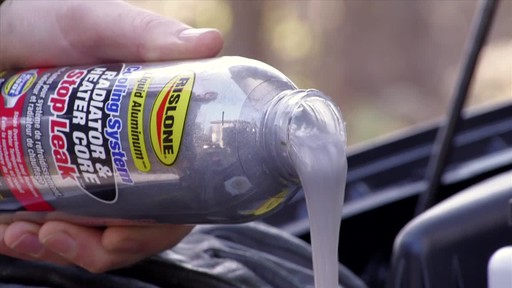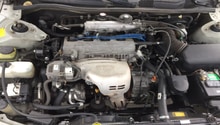Toyota Camry: How to Stop Radiator Coolant Leak
Although replacing a leaking radiator is often the best solution, stop leak products are available. These products can quickly and easily repair your Camry's leaking radiator and get you back on the road.
This article applies to the Toyota Camry (1997-2011).
The radiator is one of the main components of the cooling system that keeps your engine running at a safe temperature. A leaking radiator can lead to overheating issues and serious engine damage if left untreated. As with most modern radiators, the Toyota Camry uses an aluminum core attached to plastic end tanks. While these radiators are cost effective, they tend to develop leaks at the seams where the tanks and core meet. Additionally, neglected cooling systems are also prone to premature radiator failure since the additives in the coolant breakdown at around two to five years, and cannot adequately protect the cooling system components. It is always recommended to replace a leaking radiator; however, there are stop leak products available that individuals have used with great success. This article will outline the types of radiator stop leak available and how they can be used to cure the leaking radiator on your Toyota Camry.

Materials Needed
- Radiator pressure tester (optional)
- Stop leak product
- Turkey baster or syringe
- Funnel
When a radiator leak has developed, it is always best to install a new radiator instead of using a stop leak product. That being said, stop leak products are available for those of us who are in a financial crunch, stranded on the side of the road, or simply have a high mileage car that is not worthy of a large repair bill. If you are considering replacing your radiator, refer to this article:
Related Article: How to Replace Radiator - CamryForums.com)
Step 1 – Locate source of leak
It is important to find exactly where the leaking coolant is coming from. While most leaks can be plugged with a stop leak product, large splits in the radiator tanks or a severely damaged radiator core will require the radiator to be replaced. A handheld radiator pressure tester can quickly pressurize the cooling system and allow for any leaks to quickly present themselves. If a pressure tester is not available, a leak can often be detected with a thorough examination of the radiator. Leaking coolant will often leave a trail leading to the source. In certain cases, the engine may need to run to bring the coolant up to temperature so you can spot the leak.

Step 2 – Determine type of "stop leak" product
After identifying the leak with your radiator, it is important to decide which type of stop leak product will best suit your situation.
- Temporary Fix: Some individuals prefer not to douse their cooling system with a commercial stop leak product, but instead opt for a home remedy to get their car to a nearby service center or garage where the radiator can be replaced. Several items, including raw eggs, ground ginger, pepper, or cigarette tobacco can be poured into the radiator and allowed to circulate in the cooling system. These items have been used by shade tree mechanics for years to temporarily stop radiator leaks, because the small particles will accumulate at the source of the leak and plug it up. These items can usually be washed out of the cooling system when a new radiator is installed and will have no detrimental effects on any other cooling system components. Additionally, a cold weld product can be applied over the leak on the outside of the radiator. This is also a temporary fix as the sealant will only last so long before the high temperatures and pressure in the cooling system begin to seep past the cold weld. These temporary fixes may not work in all situations. If one of these fixes does not work, consider using a more permanent fix listed below or have your vehicle towed to a place where a new radiator can be installed.
- Permanent Fix: A more permanent solution to fixing a leaking radiator is to add a commercial stop leak product to the cooling system. Several different types of products are available to choose from. Products such as Bar's leak uses a liquid metal that will circulate the cooling system and harden in the leaking area. These work similar to cold welds, but are much more permanent as they seal off the void of the damaged area from the inside out. Similarly, some products like Justice Brother's stop leak uses a gritty sand-like formula that works much like some of the temporary fixes mentioned above, but will harden once in place of the leak. Most products will mix with all types of antifreeze coolant and can also repair leaks in the heater core, freeze plugs, and even head gaskets. Unfortunately, the remnants of these products will usually remain in the cooling system for the life of the car, even after flushing the cooling system. It is worth noting that some products will require the cooling system to be flushed before or after it is poured into it, whereas others can simply be added straight into the radiator.

Pro Tip
If attempting a temporary fix, the general consensus is to have two eggs on hand, or two-three tablespoons of pepper/ginger/or shredded tobacco.
Step 3 – Add stop leak
The Toyota Camry does not use a pressurized cooling system with a surge tank, but instead uses a traditional system with an overflow tank. For this system, stop leak can be added directly into the radiator.
- With the engine cool, open the radiator cap.
- Inspect the coolant level. If it is completely full, remove a few ounces with a turkey baster or syringe to make room for the stop leak product you will add. If the product you are using requires a radiator flush, flush the radiator prior to adding the stop leak to the system. Refer to the manufacturer's instruction label.
(Related Article: How to Flush The Cooling System - CamryForums.com)
- If using eggs, crack the eggs into the radiator and discard the shells. For pepper, ginger or tobacco, add 2 to 3 tablespoons to the radiator.
- After filling the cooling system with the stop leak product of your choice, top up the coolant level and install the radiator cap.
- With the radiator cap in place, start the car to allow the stop leak to circulate through the cooling system.
- If using a temporary stop leak fix, run the engine for 10 to 15 minutes to allow it to reach full operating temperature. If using a commercial product, follow the manufacturer's instructions for proper run time.
- After the engine has reached full operating temperature, inspect the area of the radiator that was leaking. If the area is dry, the car is ready to drive. If the leak is still present, repeat Step 3 once the engine has cooled down.

Related Discussions
- Radiator Leaking Coolant - CamryForums.com
- Coolant Leak - CamryForums.com
- Coolant Leaking? Help! - CamryForums.com






